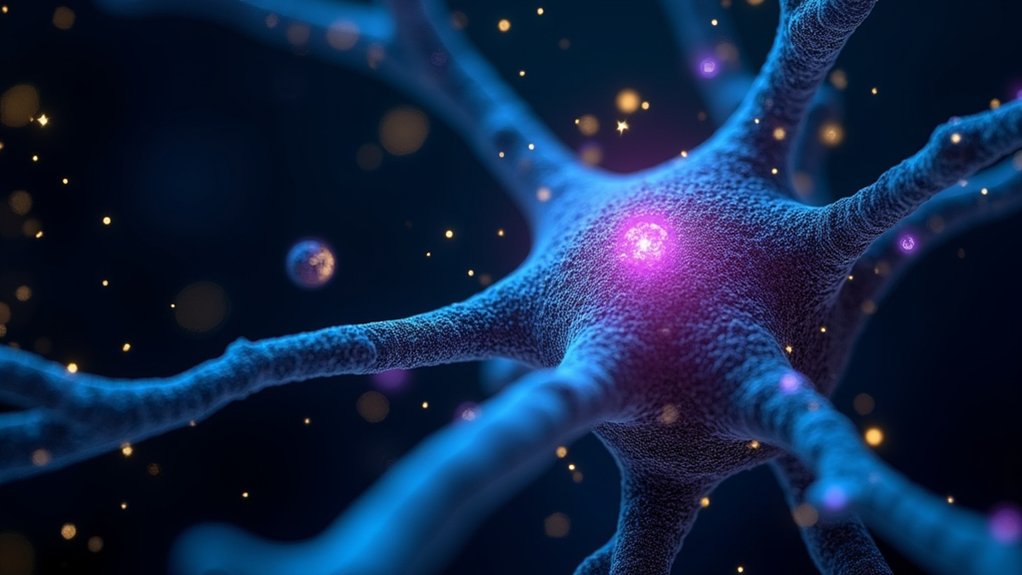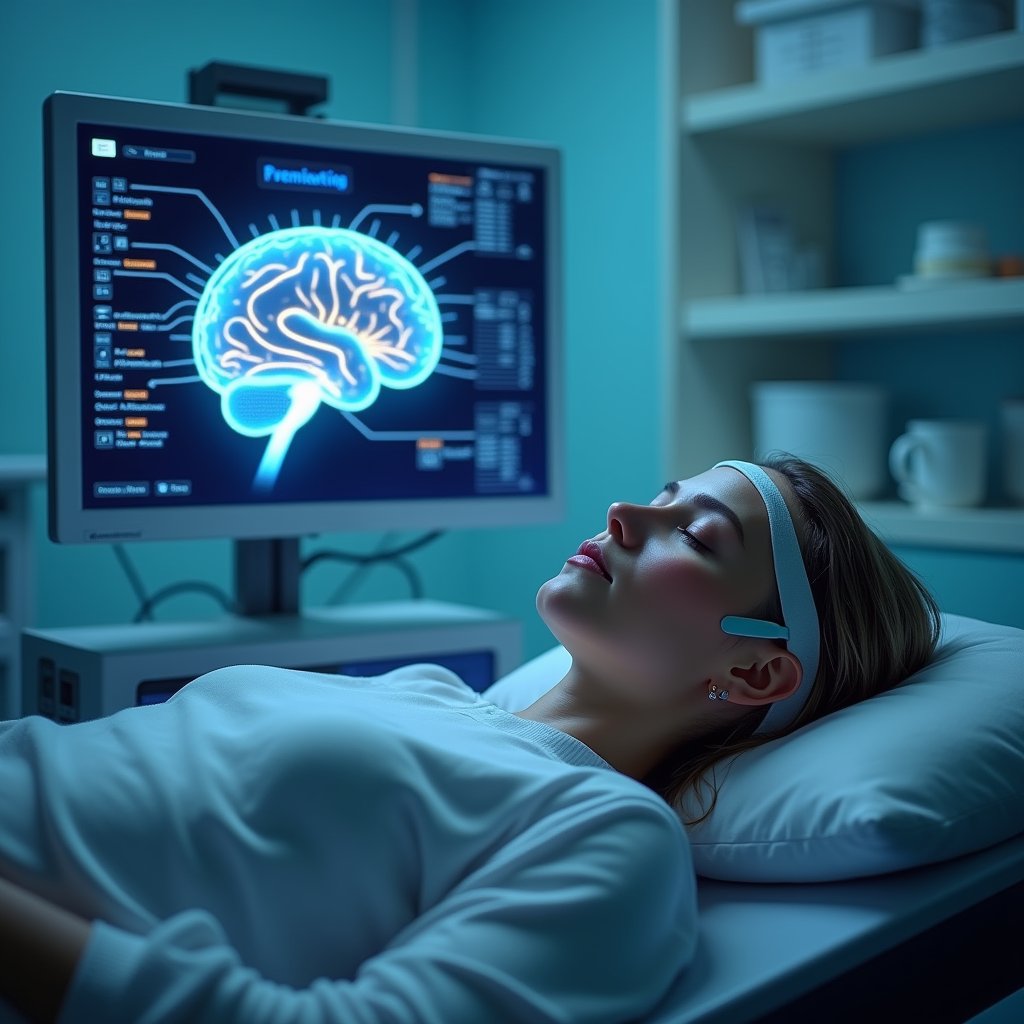Medical nitrous oxide acts as a rapid-onset anesthetic and analgesic agent in your brain through multiple mechanisms. It primarily blocks NMDA receptors while modulating GABA neurotransmission, achieving significant cerebral concentrations within minutes of inhalation. You’ll experience pain suppression through activation of the periaqueductal gray matter and enhanced noradrenergic signaling. The drug’s high lipophilicity enables efficient blood-brain barrier penetration, while its rapid washout characteristics allow precise clinical control. These intricate neural pathways reveal a complex therapeutic profile.
The Chemical Journey Through Brain Receptors

The chemical cascade initiated by nitrous oxide in the brain begins with its primary mechanism as a noncompetitive NMDA receptor antagonist. You’ll find this process blocks glutamate-mediated excitatory neurotransmission, leading to synaptic plasticity dampening and reduced memory consolidation. The gas takes just twenty seconds to reach the brain after inhalation.
As the gas molecules interact with your neural pathways, they trigger multiple receptor systems simultaneously. The GABAA receptor modulation enhances chloride influx, while reward pathway activation occurs through indirect opioid system stimulation. The rapid absorption through pulmonary capillaries ensures swift delivery to neural tissues. You’re experiencing a complex interplay where NMDA antagonism disrupts glutamate/GABA balance, while dopaminergic activity increases through opioid-mediated mechanisms. This dual action creates the characteristic effects you’ll notice: reduced excitatory signaling combined with enhanced inhibitory neurotransmission. The result is a controlled suppression of normal neural activity patterns. During this process, the brain exhibits large-amplitude slow-delta waves that sweep across the frontal regions.
Rapid Brain Entry and Distribution Dynamics
Upon inhalation, nitrous oxide rapidly traverses the alveolar-capillary membrane into your bloodstream, achieving significant cerebral concentrations within minutes due to its unique physicochemical properties. The gas’s high lipophilicity enables efficient blood-brain barrier penetration, while minimal protein binding allows unrestricted diffusion throughout cerebral tissues. Recent research shows that persistent brain changes occur after nitrous oxide exposure, particularly in visual and dorsal attention networks. The sedative induces a minimally conscious state while still allowing patients to respond to verbal commands. Once in the brain, nitrous oxide triggers dopamine release in the nucleus accumbens through D1 receptor activation.
| Distribution Phase | Time Frame | Key Effects |
|---|---|---|
| Initial Entry | 0-30 seconds | Alveolar absorption |
| Peak Distribution | 1-3 minutes | BBB penetration |
| Network Impact | 3+ minutes | Functional reorganization |
You’ll experience altered brain network dynamics as the gas modulates information processing across neural circuits. This includes measurable changes in occipital cortex connectivity and reduced efficiency in alpha/beta frequency bands. The rapid distribution profile guarantees therapeutic concentrations while maintaining stable intracranial pressure throughout exposure.
Pain-Blocking Pathways and Neural Networks

When nitrous oxide enters your central nervous system, it triggers multiple pain-blocking mechanisms through parallel neural networks, primarily mediated by activation of the periaqueductal gray matter (PAG) and locus ceruleus (LC). These neural centers orchestrate a sophisticated analgesic response through coordinated pathways.
The PAG initiates endogenous opioid peptide release, activating descending pain inhibitory systems that modulate spinal cord nociception. Within 2-5 minutes, the peak analgesic effect is achieved as the gas rapidly diffuses from the lungs into the bloodstream.
LC stimulation enhances noradrenergic signaling, suppressing pain transmission at multiple levels. The drug’s unique ability to activate descending noradrenergic neurons helps create powerful pain relief.
Due to its low blood and lipid solubility, nitrous oxide demonstrates rapid washout characteristics when administration stops.
Hypothalamic CRF integration coordinates stress responses and pain modulation through neuroendocrine pathways.
Synchronized activation of spinal and supraspinal mechanisms creates an extensive pain-blocking effect through multiple neurotransmitter systems.
This integrated network approach explains nitrous oxide’s rapid and effective analgesic properties in clinical settings.
Sedation and Consciousness Alterations
Nitrous oxide systematically modulates consciousness through multiple ion channel interactions and neurotransmitter systems, primarily targeting NMDA glutamate receptors and GABA_A receptor complexes. This dual mechanism rapidly induces altered consciousness states by suppressing excitatory pathways while enhancing inhibitory neurotransmission.
You’ll experience sedation as the gas disrupts neural vascular interactions through its high lipid solubility, allowing quick penetration of the blood-brain barrier. The drug’s activation of two-pore-domain potassium channels hyperpolarizes neurons, while its potentiation of GABA_A receptors amplifies inhibitory signaling. These combined effects modify your temporal and spatial perception, often producing euphoria or mild dissociation. These effects were first documented during laughing gas parties in 1799, where participants experienced euphoric and sedated states.
The rapid onset and reversibility of these consciousness alterations make nitrous oxide particularly valuable for controlled medical sedation, with effects dissipating quickly upon discontinuation.
Neurotransmitter Interactions and Signaling

Through complex interactions with multiple neurotransmitter systems, medical nitrous oxide orchestrates a cascade of signaling events that modulate neural activity. Your brain’s response involves intricate mechanisms affecting regional brain activation patterns and mitochondrial energetics disruption across neural networks. Research shows that N2O has minimal effects on GABA receptors compared to other anesthetic agents.
Key neurotransmitter interactions include:
- NMDA receptor antagonism, reducing glutamate signaling and dampening pain transmission
- Activation of brainstem opioid systems, triggering endogenous pain-relief pathways
- Nitric oxide-mediated retrograde neurotransmission, affecting synaptic plasticity through cyclic GMP signaling
- Modulation of α2 adrenoceptors and benzodiazepine receptors, contributing to anxiolytic effects
These interactions create a coordinated response affecting consciousness, pain perception, and mood regulation through precisely timed neurotransmitter release and receptor modulation, ultimately producing the drug’s characteristic therapeutic effects. The neurotransmitter activity also influences vessel control through specialized pathways that regulate cerebral blood flow.
Physiological Effects on Body Systems
Medical administration of nitrous oxide triggers widespread physiological changes across multiple organ systems, producing both therapeutic benefits and potential complications you’ll need to monitor.
When you’re administering nitrous oxide, you’ll observe decreased tidal volume with compensatory increased respiratory rate, creating respiratory depression risk in susceptible patients. The agent impairs your hypoxic ventilatory response while elevating cerebral blood flow and intracranial pressure. Nitrous oxide exists in both liquid and vapor phases when stored in pressurized cylinders. Patients commonly experience a rapid euphoric rush followed by feelings of dissociation. Since its discovery in the late 18th century, nitrous oxide has been used recreationally for its euphoric effects.
You’ll notice minimal systemic blood pressure changes due to compensatory sympathetic activation, though it does increase pulmonary vascular resistance.
Long-term exposure can lead to vitamin B12 depletion, potentially causing peripheral neuropathy and psychiatric complications. You’ll need to watch for mucociliary dysfunction and reduced regional blood flow to organs like the kidneys and liver. These effects necessitate careful patient selection and monitoring, particularly in those with pre-existing pulmonary hypertension or compromised cerebral autoregulation.
Safety Profile and Clinical Monitoring
When administering nitrous oxide sedation, you’ll need to maintain continuous monitoring of critical signs including blood pressure, heart rate, respiratory rate, and oxygen saturation levels.
Your clinical environment must adhere to strict occupational exposure thresholds, with NIOSH limiting ambient nitrous oxide to 25 ppm per procedure and ACGIH setting an 8-hour time-weighted average limit of 50 ppm.
Since nitrous oxide induces a state of conscious sedation, patients remain responsive to instructions while maintaining their ability to communicate with medical staff throughout the procedure.
You must utilize real-time gas concentration monitors and scavenging systems while following ventilation protocols to necessitate both patient safety and workplace compliance with these established limits.
Vital Sign Tracking Requirements
Proper critical sign monitoring during nitrous oxide administration forms the cornerstone of safe clinical sedation practice. When you’re receiving nitrous oxide sedation, healthcare providers must maintain rigorous documentation of your physiological parameters to guarantee dose requirements align with safety protocols and proper patient education.
Key vital sign monitoring necessities include:
- Continuous SpO₂ tracking via pulse oximetry, with baseline documentation and alerts for ≥2% drops
- Regular assessment of respiratory rate and end-tidal CO₂ through waveform capnography
- Blood pressure and heart rate measurements at predetermined intervals
- Ramsay Sedation Scale scoring to evaluate consciousness levels
These parameters require precise documentation throughout your procedure, from pre-administration baseline readings through post-treatment recovery. Your healthcare team utilizes specialized monitoring tools, including combination nasal cannulas, to simultaneously deliver nitrous oxide and track vital signs.
Occupational Exposure Limits
Safe occupational exposure limits for nitrous oxide require stringent monitoring and control measures in clinical settings. You’ll need to adhere to NIOSH’s recommended exposure limit of 25 ppm TWA, though regulatory compliance varies internationally, with HSE allowing up to 100 ppm for maternity workers. Exposure reduction strategies must incorporate demand valve systems and scavenging equipment that maintains 70% efficiency.
Your workplace monitoring should include regular air sampling to guarantee N₂O levels don’t exceed safety thresholds, particularly in high-risk areas like dental operatories where concentrations can reach 1,000 ppm without proper controls. You must maintain oxygen levels above 19% by volume and implement local exhaust ventilation, as general room ventilation alone won’t sufficiently protect staff from chronic exposure risks.
Metabolic Processing and Elimination Routes
While nitrous oxide undergoes minimal metabolic transformation in the body, its processing and elimination follow distinct physiological pathways. The gas’s tissue solubility dynamics influence its distribution, though elimination occurs primarily through pulmonary excretion. Understanding these metabolism elimination correlations helps explain the gas’s unique pharmacokinetic profile.
The compound’s high blood solubility (30-40 times greater than nitrogen) affects tissue distribution but doesn’t alter its elimination route through exhalation. You’ll find no significant hepatic or renal processing occurs during elimination. Limited bacterial metabolism takes place in the gastrointestinal tract. The gas’s interaction with B12-dependent enzymes creates metabolic effects that remain reversible upon cessation.
These pathways demonstrate how nitrous oxide maintains its clinical utility while following predictable elimination patterns, making it valuable for medical applications.
Long-Term Exposure Considerations
Long-term nitrous oxide exposure presents distinct physiological and psychological risks that extend beyond its acute elimination patterns. You’ll experience neurological consequences including memory impairment, limb spasms, and potential paralysis due to progressive nerve damage.
The gas’s mechanism of vitamin B12 depletion critically disrupts DNA synthesis and cellular metabolism, leading to megaloblastic anemia and compromised immune function.
You’re particularly vulnerable to developing psychological complications, including depressive episodes and cognitive decline that may persist after cessation. The compound’s effects on your nervous system can manifest as tinnitus, incontinence, and numbness in extremities.
When combined with other substances, you’ll face heightened risks of adverse reactions, while regular exposure often leads to tolerance development and psychological dependence. These systemic impacts underscore the importance of careful monitoring in medical applications.
Therapeutic Applications in Modern Medicine
Medical nitrous oxide has carved out diverse therapeutic applications across multiple clinical specialties, leveraging its unique pharmacodynamic profile. Its anesthetic properties make it particularly valuable across a spectrum of clinical applications, from minor surgical interventions to obstetric care.
Key therapeutic applications include:
- Pain management during minor procedures, including dermatological interventions like laser treatments, dermabrasion, and photodynamic therapy
- Anxiolysis in dental procedures and non-invasive medical tests, where it’s proven effective as both a primary and adjunctive sedative
- Obstetric pain relief, offering an alternative to epidural anesthesia while maintaining maternal mobility during labor
- Specialized medical scenarios such as acute pancreatitis pain management and palliative care, where its rapid onset and controllable sedation prove beneficial
You’ll find these applications particularly effective when integrated into extensive treatment protocols.
Frequently Asked Questions
Can Nitrous Oxide Cause Permanent Memory Loss or Brain Damage?
Yes, nitrous oxide can cause permanent brain damage and memory loss, particularly through chronic exposure.
You’ll experience cognitive impairment through B12 inactivation, which disrupts myelin formation and neuronal function. Delayed neurological effects may include peripheral neuropathy and spinal cord degeneration.
While some damage can be reversed with early B12 supplementation, chronic exposure often leads to permanent neurological deficits, especially if treatment isn’t initiated promptly.
How Long Does Laughing Gas Stay Detectable in Blood Tests?
Your blood will show detectable levels of nitrous oxide for a very short period due to its rapid absorption rate and elimination timeline. The gas has a half-life of only 5-15 minutes in your bloodstream, and you’ll typically clear it from your system within minutes after stopping inhalation.
However, if you’re a chronic user, detection might extend up to 3 hours post-use. Standard blood tests must be conducted quickly after exposure for accurate results.
Why Do Some People Experience Euphoria While Others Feel Anxiety?
Your individual biochemical responses to nitrous oxide markedly determine whether you’ll experience euphoria or anxiety. If you have ideal opioid receptor function and balanced GABA levels, you’re more likely to feel euphoric.
However, your underlying psychological factors, including pre-existing anxiety disorders or negative expectation bias, can override positive biochemical effects. Your unique neurotransmitter profile and stress response mechanisms ultimately shape how you’ll react to the gas.
Does Regular Dental Nitrous Oxide Use Affect Fertility?
Yes, prolonged exposure to dental nitrous oxide can markedly impact your reproductive health. Research indicates that regular exposure (≥5 hours/week) may reduce female fertility by up to 59% compared to unexposed individuals.
The gas interferes with LHRH and LH hormone release, potentially disrupting ovulation cycles. It’s also linked to vitamin B12 metabolism disruption, which affects reproductive enzyme function.
Healthcare workers with chronic exposure show increased rates of fertility complications and pregnancy risks.
Can Nitrous Oxide Interactions With Antidepressants Cause Serotonin Syndrome?
Yes, nitrous oxide can potentially trigger serotonin syndrome when combined with antidepressants, particularly SSRIs and SNRIs. You’re at risk due to possible drug interactions between N2O’s effects on nitric oxide signaling and serotonin pathways.
While documented cases are limited, long term complications can include autonomic instability and neurological abnormalities. You’ll need careful screening if you’re on antidepressants before receiving N2O, as these interactions could lead to serious serotonergic toxicity.

